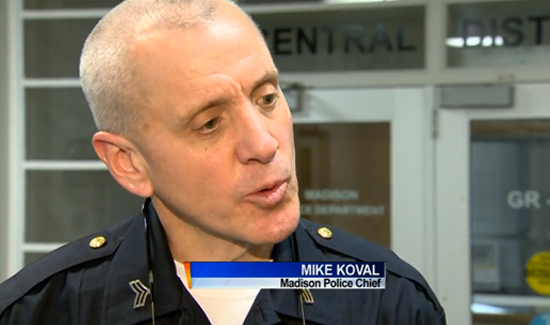Police and Attorney Say “No Way” to Restrictive Use of Force Policy

While saying it found “much to agree with” in a consultant’s report, the Madison Police Department and its union has rejected a recommendation to move toward a more stringent standard for the use of deadly force. They also raised issues concerning potential problems with appointing a civilian-controlled outside auditor to oversee the department.
According to a report by Chris Rickert in the Wisconsin State Journal, a just-released 76-page document reveals the Police Department addresses each of 146 recommendations made in the California-based OIR Group’s report, released Dec. 14 after a year of research and in the wake of a string of high-profile fatal police shootings.
Taking its cue from the consultant’s determination that the department “is far from ‘a Department in crisis,’” police said they “view the report and recommendations not as a roadmap to ‘fix’ a troubled department, but as a resource to help move an outstanding agency to an even higher level.”
The city’s police union and City Attorney Mike May also provided written responses to some of the recommendations.
 Among the biggest drivers of the City Council’s decision to commission the $372,000 report was the fatal police shooting of an unarmed black 19-year-old in 2015. While the city’s insurer has paid out three multi-million dollars settlements in three of seven fatal police shootings since 2012, in only one case were police found at fault, in civil court.
Among the biggest drivers of the City Council’s decision to commission the $372,000 report was the fatal police shooting of an unarmed black 19-year-old in 2015. While the city’s insurer has paid out three multi-million dollars settlements in three of seven fatal police shootings since 2012, in only one case were police found at fault, in civil court.
OIR recommended Madison police consider using a more restrictive standard for when deadly force can be deployed than the “objective reasonableness” standard set out in the 1989 U.S. Supreme Court decision Graham v. Connor. It precludes police from using deadly force unless, at the time of an incident, it seemed objectively reasonable to believe deadly force was necessary to keep someone from getting killed or seriously injured.
But the department said it would be “unwise” to adopt a different standard and notes “the OIR report seems strangely dismissive of Graham as ‘a 30-year old Supreme Court case.’ No one would view Miranda v. Arizona that way, but Graham has been every bit as impactful on American policing as Miranda has.”
May said he knows of no other police department in the United States that uses a more stringent standard than the one laid out in Graham and that “MPD trains its officers that deadly force is a last resort and already deploys less lethal force options such as bean bag rounds and Tasers.
“Moving away from the Graham v. Connor standard could mean the officers could only employ deadly force after they have been attacked, shot at or injured,” he said.
OIR has also recommended the city hire an outside police auditor under the control of a civilian board. Police didn’t take a position on that — instead saying it was up to the community and city elected officials — but noted that, unlike Madison, “many of the jurisdictions with expansive civilian oversight mechanisms are larger agencies with a significant history of insufficient internal accountability.”
The department also said that many of the places with such oversight don’t have state laws like the one in Wisconsin requiring municipal police and fire commissions, which are appointed by mayors and act to hire and discipline police.
May said “there may be a lot to gain in terms of public trust in the MPD if a truly independent and professional auditor could provide some outside review of incidents,” but that the proposal depended on factors including how the office was set up and how it would interact with the Madison Police and Fire Commission.
Madison has so far declined to join the growing ranks of American cities that equip patrol officers with body-worn cameras, and OIR said the city should seek input from the community and devise policies on the use of the cameras before adopting them.
But it made no formal recommendation on their use, other than to advise against it if a state bill passes that would severely restrict the release of camera footage.
Police said the decision on cameras was also one for the mayor and City Council, but May said his office supports them “for the simple reason that the cameras will assist the city in determining potential civil liability.”
The Madison police union, the Madison Professional Police Officers Association, said it supports a body camera pilot project; the council has previously rejected that move. The union said that while cameras “will not build trust” between police and some parts of the community, they do “provide a level of transparency that can’t be achieved in other ways” and that “can help MAINTAIN trust.”
OIR also made several recommendations related to allowing the community and police supervisors have more control over which officers work specialized assignments — including those for neighborhood officers and school-based officers — and for how long.
Those assignments are now based in part on seniority, under the MPPOA’s contract with the city, but union officials said they were open to continue talking about changes that would allow some officers to remain on specialized assignments longer, although they noted this can preclude other talented officers from taking on the duties.
In an appendix to its response, Madison police also pointed to what it calls 18 distinct errors in OIR’s report, which it says it wasn’t allowed to review in draft form. They include errors about how many neighborhood officers each police district has, what information the department’s record management system tracks and how the department deploys Tasers.














